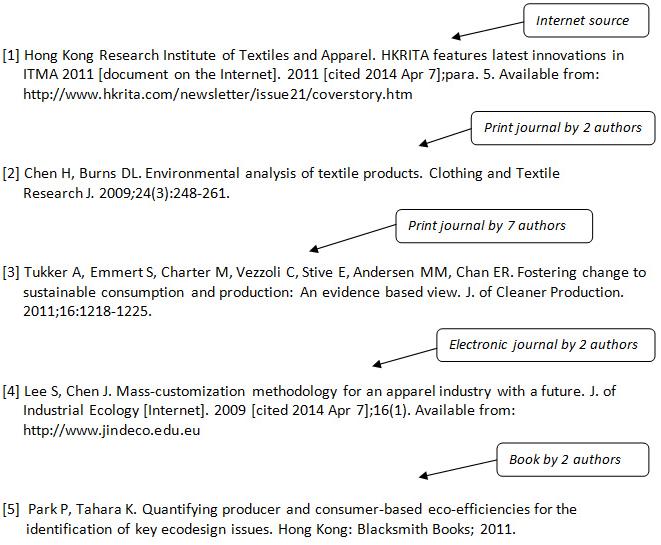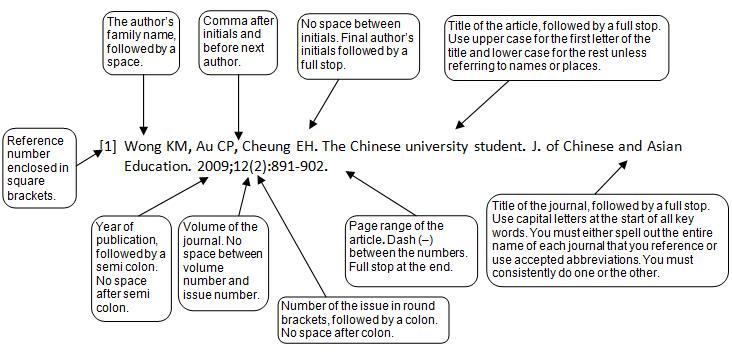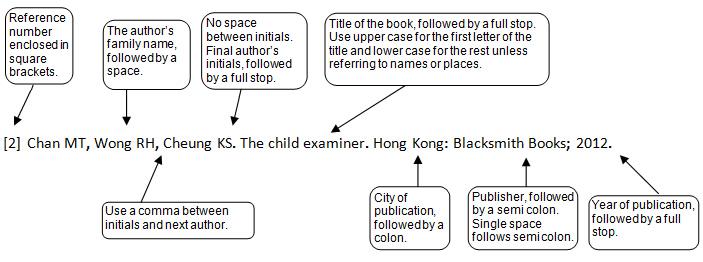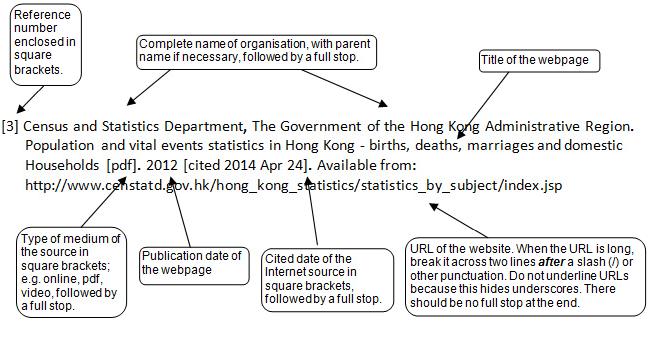Vancouver Referencing Guide
The Vancouver referencing system 
The page was last updated on 10 November 2016.
Referencing is a standard practice for acknowledging information sources in academic writing at university. Whenever you write an assignment that requires you to find and use information, you are expected to reference all the sources of information and ideas included in your writing.
This webpage provides guidelines for using the Vancouver referencing system. There are two components to a Vancouver reference:
- an in-text reference in the body of your assignment:
Chan [1] explores a range of themes and ideas ...
- full reference details in your reference list:
[1] Chan DP. Business in China. Hong Kong: Dragon Press; 2011.
Part 1 Basic rules
Why do we reference?
Most academic assignments require wide reading so that previous and current thinking about a particular topic can be identified. It is important to show your reader that you have sought out expert, reliable sources to help support and develop your thinking on your topic. The referencing in your assignment should:
- demonstrate good research practice
- show the range of ideas and approaches you have found and thought about
- acknowledge where those ideas came from
- tell your reader where they can locate the sources you have used
Referencing also helps you to avoid plagiarism. If you present someone else's ideas, and/or the way they express their ideas, as if they are your own work, you are committing plagiarism. Plagiarism can be unintentional due to poor referencing, but the consequences are always serious. Accurate referencing helps you to avoid this.
i. When to reference
Every time you include someone else's words, ideas or information in your assignment, an in-text reference must be provided. Insert an in-text reference whenever you:
- paraphrase someone else's ideas in your own words
- summarise someone else's ideas in your own words
- quote someone else's ideas in their exact words
- copy or adapt a diagram, table or any other visual material
ii. How to reference
An in-text reference is provided each time you refer to ideas or information from another source, and includes the following details:
the author's family name (do not include given names) + reference number in square brackets
There are two main ways to present an in-text reference:
a) Integral referencing
The reference is in the body of your sentence, with the author's family name integrated into the sentence structure, and the reference number is given in square brackets. This type of reference is often used when you want to give prominence to the author.
Lam [2] argues that Hong Kong needs to further assimilate into the Pearl River Delta economy if its long term growth is to be assured.
b) Non-integral referencing
The reference number is enclosed in the sentence in square brackets. This type of reference is often used when you want to give prominence to the information.
The Hong Kong economy expanded by 2.3% in the third quarter of 2011 [3].
[3] Census and Statistics Department, The Government of the Hong Kong Special Administrative
Region. Hong Kong economic trends. Hong Kong: Census and Statistics Department; 2012 Apr.
iii. Including page numbers
Page numbers should be included in your in-text reference and reference list when you:
- use a direct quote from a particular source
- copy tables or figures, or present specific information like dates/statistics
Cheung [4:296] notes that "universities in Hong Kong need to strengthen their academic credentials" if they are to compete in the world economy.
[4] Chung H. Chinese universities and the future. J. of Asian Educational Research. 2012;84(8):296.
You can also include a page number when you take an idea from a particular page. However, it would not be appropriate academic style to include a page number in all or most of your in-text citations if you are only taking ideas from a source.
iv. Use of "et al."
Where there are two or more authors, only the first author should be used followed by "et al." (which is Latin for et alia) meaning and others:
Wong et al. [5] found that the majority ...
The following chart shows how to format in-text citations for Vancouver referencing style:
| Type of citation → | Integral | |
| Number of authors ↓ | First citation in text | Subsequent citations in text |
| One author | Chan [1] argues ... | Chan [1] argues ... |
| Two or more Authors | Chan et al. [2] suggest ... | Chan et al. [2] suggest ... |
| Groups (easily identified by abbreviation) as authors | The Hong Kong Housing Authority (HKHA) [3] states ... | The HKHA [3] states ... |
| Groups (no abbreviation) as authors | Animals Asia [4] defines ... | Animals Asia [4] defines ... |
v. Ellipsis and Square brackets
Ellipsis refers to dots in the middle of a sentence. Their purpose is to let the reader know that some part of a quotation has been left out. If it is necessary to interrupt a quotation you are citing in order to clarify something, you should enclose your remarks in square brackets.
Original: "Students in the university should study outside class, in all credit bearing subjects, for at least 6 hours a week."
With text omitted and clarification: "Students in the university [The Hong Kong Polytechnic University] should study outside class ... for at least 6 hours a week."
Sample text with in-text referencing and reference list
Vancouver in-text referencing uses the author's surname and the reference number in square brackets for integral citations, and the reference number in square brackets for non-integral citations. Include a page number (or paragraph number for online sources) in the reference list for direct quotations. The reference list is in numerical order.
Until recently, development in the textile and clothing industry has focused on "technological and cost aspects" [1:5]. According to Chen et al. [2:249], emphasis has been placed on keeping the price of the “final product low and increasing efficiency in production”. Tukker et al. [3] further point out that designers, manufacturers and retailers have paid less attention to other factors such as ownership and related business models, as well as consumer wishes and values. Hence, the products are designed and produced according to regularly changing trends that enable a quick profit [4], rather than radically rethinking the ways of designing and manufacturing the offering that is based on consumer needs and sustainability as proposed by Park et al. [5].
References

1. What it does
The reference list provides full bibliographic details for all the sources referenced in your essay so that readers can easily locate the sources. Each different source referenced in your essay must have a matching entry in your reference list.
It is important to note that the reference list is not a bibliography. A bibliography lists everything you may have read, while a reference list is deliberately limited to those sources for which you have provided in-text references. A bibliography is not needed unless specifically requested by your lecturer.
2. How it looks
The reference list is titled "References" and must be:
- ordered as they appear in the in-text references (in order of citation, not in alphabetical order).
- a single list where books, journal articles and electronic sources are listed together. Do not divide into separate lists.
The main elements required for all references are the author's name(s), year, title and publication information. The basic reference formats are shown in the following examples. These should be followed exactly, paying special attention to details of capitalisation, punctuation and order of information.
3. Journal article format
| [Reference number] | First author's surname Initials,Second author's surname Initials,Third author's surname Initials.Title of article.Name of journal.Year;Volume number(Issue number):Page range of article. |

4. Book format
| [Reference number] | First author's surname Initials,Second author's surname Initials,Third author's surname Initials.Title of book.City of publication:Publisher;Year. |

5. Internet source format
| [Reference number] | Name of organisation.Title of article[type of medium].Year[citedYear Month Day]. Available from:URL |

1. How do I cite two or more authors?
When there are two or more authors for a reference, you should only use the first author's family name in the in-text reference followed by the abbreviation "et al.". For a non-integral reference, only include the reference number in square brackets. For example:
- According to Choi et al. [1], students in Asia are more studious than their North American counterparts.
- Wong et al. [2] strongly support the use of technology in the classroom.
- Asian students devoted on average 16 hours per week to out-of-class study compared to 10 hours for North American students [3].
2. In the reference list what should I do when there is many authors?
If there are more than two authors:
List by last names and initials. Separate names by a comma after the initials.
[4] Chow RK, Ping SM. Mood management in university students. J. of
Asian Psychology. 2004;45(3):1034-1048.
[5] Luk WK, Chan YK, Sing AN, Burton H, Heart L, Burns HU. The Chinese student: A study. J. of East Asian Psychology. 2009;32(5):1190-1204.
If there are many authors:
Give all authors, regardless of the number.
[6] Tukker A, Emmert S, Charter M, Vezzoli C, Stive E, Andersen MM, Chan ER. Fostering
change to sustainable consumption and production: An evidence based view. J. of
Cleaner Production. 2011;16:1218-1225.
3. How do I cite when there is no author and/or no date?
When no person is mentioned, include the title of the source or the authoring/sponsoring organisation in place of the author.
For example:
- The English Language Centre [7] aims to improve students' communication skills to enable them to attain excellent results in their academic and professional lives.
When no date of publication is given but the publication contains a date of copyright, use the date of copyright preceded by the letter "c"; for example c2012. If neither a date of publication nor a date of copyright can be found, but a date can be estimated, insert a question mark after the estimated date and place date information in square brackets. If the date of publication cannot be estimated, use [date unknown].
[8] Amano Y. Final fantasy: 20th anniversary artbook. Macau: ACG Studio; [date unknown].
[9] Equal Opportunities Commission. Equal treatment for native speakers.
Hong Kong: Equal Opportunities Commission; [2001?].
However, be cautious about using sources without dates. A source with no date might not be reliable.
4. How do I present exact quotations?
Short quotations of fewer than thirty words should be enclosed in double quotation marks (" ... ") and be accompanied by an in-text reference. Remember to include the page or paragraph number after the reference number in square brackets and in the reference list so that the reader can find the quotation.
For example:
- Research by Leung [10:15] indicates that "students in Hong Kong devote on average 5 hours a week to their English studies from the age of four".
Longer quotations of more than thirty words should be presented without quotation marks and indented (using Tab key) at the left. Include the page or paragraph number in the complete reference list.
For example:
According to Obama [11:45], America:should be more modest in our belief that we can impose democracy on a country through military force. In the past, it has been movements for freedom from within tyrannical regimes that have led to flourishing democracies; movements that continue today. This does not mean abandoning our values and ideals; wherever we can, it’s in our interest to help foster democracy through the diplomatic and economic resources at our disposal.
5. Where exactly do I put the full stop when quoting and/or citing?
Full stops must always be placed at the very end of a sentence, after the quotation and/or in-text reference. For example:
- According to Mooney [12:34], "exam pressure in Hong Kong has lessened slightly in the past decade".
- Research indicates that students in Hong Kong have had four mobile devices before their 18th birthday [13].
6. Can I cite two or more sources at the same time?
Yes you can. Study the following examples.
Example 1: ... as shown by Chan [4], [5];
Example 2: ... as mentioned earlier [2], [4]–[7], [9];
Example 3: ... Wong [4] and Brown and Jones [5];
In example 1, Chan has at least two articles in the reference list. In example 2, there are six references mentioned. In example 3, there are two integral references.
7. Can I paste the URL of a webpage into my essay as an in-text citation?
No. Follow the Vancouver referencing conventions for all sources. If you are unsure how to reference a website because there is no author or date information, follow the guidelines provided below for referencing sources without authors or dates.
8. How do I cite information from one author (Author 1) which I have found in a book or journal article by another author (Author 2)?
This is secondary citation. Vancouver style does not allow for the use of secondary sources in in-text citations. You should try to locate the original source of information which is cited in a work which you have read. If an original source cannot be located, you should cite it as following in the reference list.
[14] Cooper M. Relapse and craving: A commentary. Alcohol Alert. 1989;6:3. Cited by Hull BT, Kline C, Tulper KE. Alcohol and degeneration. J. East Asian Medicine. 2008;6(3):761-7.






